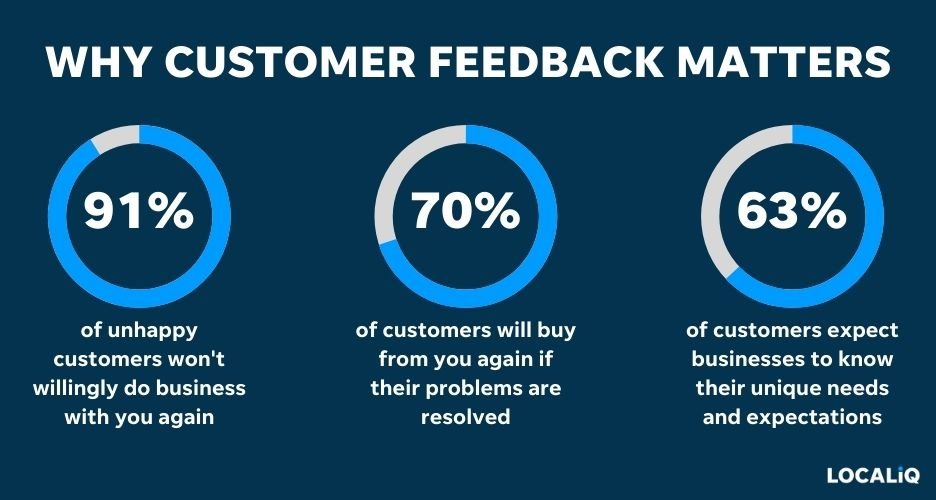
The Importance of Customer Feedback in Marketing Strategies
Posted on June 5, 2022
In today’s competitive market, businesses are increasingly focused on improving customer experiences to gain a competitive edge. One of the most effective ways to do this is by gathering and utilizing customer feedback to refine marketing strategies. Customer feedback provides valuable insights that can drive better decision-making, product development, and targeted marketing. Here, we’ll explore the essential role of customer feedback in shaping effective marketing strategies, including its benefits, methods of collection, and ways to incorporate it into a dynamic marketing approach.
Why Customer Feedback Matters in Marketing
- Understanding Customer Needs and Preferences
Customer feedback is a direct line to understanding what your target audience truly wants. This insight allows you to tailor your marketing messages to better meet customer expectations. By addressing their specific needs, you not only increase customer satisfaction but also enhance brand loyalty. - Improving Products and Services
Feedback enables companies to identify areas where products or services may fall short. By listening to customers’ suggestions and complaints, businesses can make data-driven decisions to refine their offerings, leading to improved customer satisfaction and brand reputation. - Enhancing Customer Retention
When customers feel heard, they are more likely to stay loyal to your brand. Using feedback in marketing strategies shows customers that their opinions matter, leading to long-term relationships and better customer retention rates. - Building Trust and Transparency
Collecting and acting on feedback demonstrates a brand’s commitment to transparency. Customers are more likely to trust a brand that actively seeks out and responds to feedback, ultimately strengthening the brand’s reputation. - Fine-Tuning Marketing Campaigns
Feedback can help marketers test the effectiveness of campaigns and make adjustments in real time. It allows for quicker adaptations, such as adjusting messaging, targeting different demographics, or switching channels, making campaigns more efficient and impactful.
Methods of Collecting Customer Feedback
- Surveys
Surveys are a popular tool for gathering structured feedback. They allow for both quantitative and qualitative responses, making it easier to analyze patterns and identify areas of improvement. Platforms like Google Forms, Typeform, and SurveyMonkey offer easy-to-use templates for collecting feedback at scale. - Social Media
Social media channels are excellent for real-time customer feedback. Through comments, direct messages, and mentions, brands can gauge customer sentiment and respond to inquiries or concerns immediately. - Customer Reviews and Testimonials
Reviews and testimonials provide authentic feedback that reflects the customer’s experience. Platforms like Google Reviews, Yelp, and Trustpilot are valuable resources for collecting unbiased customer feedback. - Focus Groups and Interviews
While time-intensive, focus groups, and one-on-one interviews offer deep insights into customer thoughts and preferences. These methods allow for open-ended questions, making them ideal for gathering detailed, qualitative data. - Feedback Forms and Customer Service Interactions
Many companies use feedback forms on their websites or apps, allowing customers to submit comments after purchases or service experiences. Customer service teams can also provide indirect feedback based on common issues or inquiries.
Incorporating Customer Feedback into Marketing Strategies
- Segmentation and Personalization
Use feedback to create detailed customer personas, which allows for targeted marketing strategies. By understanding what resonates with different segments of your audience, you can personalize your messaging to increase engagement and conversion rates. - Content Creation and Messaging
Feedback can guide the development of marketing content that addresses customer pain points, interests, and questions. If customers frequently ask about certain features, create content that addresses those areas, such as blog posts, FAQs, or tutorial videos. - Product Development and Updates
Marketers can work closely with product development teams to ensure that customer feedback directly informs product improvements. By promoting new or updated features based on customer suggestions, marketers can reinforce the brand’s commitment to customer satisfaction. - Customer Success Stories and Case Studies
Positive feedback can be turned into success stories or case studies, demonstrating the impact of your product or service. Sharing these stories helps potential customers understand the value you offer and can strengthen your brand’s credibility. - Loyalty Programs and Reward Systems
Implementing loyalty programs based on feedback can show appreciation for customers’ insights and encourage continued engagement. These programs can be tailored to reward behaviors that align with your business goals, like frequent purchases or referrals. - Tracking and Measuring Success
Regularly review feedback to identify trends and measure the effectiveness of your marketing strategies. Feedback allows you to set benchmarks and track progress over time, ensuring that marketing efforts remain customer-centered.
Benefits of a Feedback-Driven Marketing Approach
- Increased Customer Loyalty: By responding to feedback, companies can foster loyalty and a sense of community.
- Higher Conversion Rates: Marketing messages that resonate with customer needs are more likely to lead to conversions.
- Improved Brand Reputation: Feedback-driven strategies emphasize transparency, boosting brand credibility and trust.
- Reduced Churn: Satisfied customers are less likely to switch to competitors, reducing churn rates.
- Greater Innovation: Customer insights often reveal new opportunities for innovation in product or service offerings.
Overcoming Challenges in Collecting and Using Feedback
While customer feedback is invaluable, integrating it into marketing strategies can present challenges. These include managing large volumes of feedback, dealing with negative comments, and ensuring that data is actionable. To overcome these challenges, brands should:
- Use automated tools to streamline the feedback collection process.
- Address negative feedback professionally and transparently.
- Develop a system for categorizing and prioritizing feedback based on its relevance to strategic goals.
Conclusion
Customer feedback is an indispensable element of effective marketing strategies. By embracing feedback as a tool for continuous improvement, businesses can develop stronger customer relationships, drive innovation, and achieve better marketing outcomes. A customer-centered approach to marketing, where feedback shapes decision-making, is a pathway to sustainable success in today’s dynamic market landscape.
